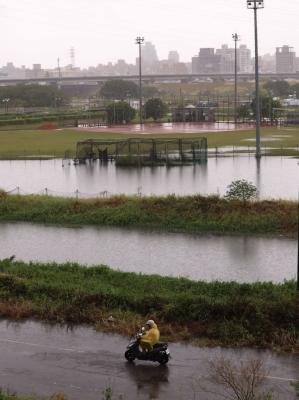China is developing the means to electronically blockade rival Taiwan with attacks to the country's vital utilities, the Internet and other communications networks, a high-ranking US defense official has said.
The stern warning was issued by Richard Lawless -- deputy undersecretary of defense -- during a closed-door meeting with business leaders last month in the US. A copy of Lawless' speech was obtained by The Associated Press yesterday under the US Freedom of Information Act.
Lawless cautioned that if a war broke out between Taiwan and China, the first casualties might not be "brave men and women in uniform." He said China might first target things that keep Taiwan's high-tech society running.
"China is actively developing options to create chaos on the island, to compromise components of Taiwan's critical infrastructure: telecommunications, utilities, broadcast media, cellular, Internet and computer networks," Lawless said on Oct. 4 to the US-Taiwan Business Council.
``Taiwan could be electronically blockaded, isolated from the world, creating a kind of perfect storm in which the US could not communicate with Taiwan or Taiwan with the world,'' Lawless said during the council's meeting in the southwestern city of Scottsdale, Arizona.
Lawless said such a strategy could be called an "acupuncture" attack aimed at "the destruction of a national will" with "the insertion of a hundred needles."
Beijing insists that self-ruled, democratic Taiwan is part of China and has repeatedly threatened to attack if the Taiwanese seek a permanent split or delay too long on unification.
Much of the debate over whether China will invade has focused on China's growing arsenal of destroyers, jets, submarines and hundreds of missiles aimed at Taiwan, just 160km off China's southern coast.
But in recent years, analysts have touted the possibility that China could be developing new high-tech weapons that could give the Chinese an edge over US forces -- which are widely expected to help defend Taiwan.
Lawless said that several recent incidents have exposed vulnerabilities in Taiwan's critical infrastructure and communication systems and that China is aware of these weak spots.
In 1999, the loss of a single transformer station on Taiwan "left thousands without power for weeks," while a massive earthquake the same year "left Taiwan dependent on satellite communications to the outside world for more than a month."
"Many feared China would attempt to take advantage of Taiwan's ill fortune," Lawless said.
Taiwan must do more to safeguard telecommunications, fiber optics, energy supplies and major transportation arteries, and should consider allowing private agencies to assist in national defense, he said.
"Taiwan is one of the most technologically advanced societies in the world, but the expertise and wealth of experience that exist in the private sector remains largely untapped," he said.

TRAFFIC SAFETY RULES: A positive result in a drug test would result in a two-year license suspension for the driver and vehicle, and a fine of up to NT$180,000 The Ministry of Transportation and Communications is to authorize police to conduct roadside saliva tests by the end of the year to deter people from driving while under the influence of narcotics, it said yesterday. The ministry last month unveiled a draft of amended regulations governing traffic safety rules and penalties, which included provisions empowering police to conduct mandatory saliva tests on drivers. While currently rules authorize police to use oral fluid testing kits for signs of drug use, they do not establish penalties for noncompliance or operating procedures for officers to follow, the ministry said. The proposed changes to the regulations require

The Executive Yuan yesterday announced that registration for a one-time universal NT$10,000 cash handout to help people in Taiwan survive US tariffs and inflation would start on Nov. 5, with payouts available as early as Nov. 12. Who is eligible for the handout? Registered Taiwanese nationals are eligible, including those born in Taiwan before April 30 next year with a birth certificate. Non-registered nationals with residence permits, foreign permanent residents and foreign spouses of Taiwanese citizens with residence permits also qualify for the handouts. For people who meet the eligibility requirements, but passed away between yesterday and April 30 next year, surviving family members

Taipei, New Taipei City, Keelung and Taoyuan would issue a decision at 8pm on whether to cancel work and school tomorrow due to forecasted heavy rain, Keelung Mayor Hsieh Kuo-liang (謝國樑) said today. Hsieh told reporters that absent some pressing reason, the four northern cities would announce the decision jointly at 8pm. Keelung is expected to receive between 300mm and 490mm of rain in the period from 2pm today through 2pm tomorrow, Central Weather Administration data showed. Keelung City Government regulations stipulate that school and work can be canceled if rain totals in mountainous or low-elevation areas are forecast to exceed 350mm in

China Airlines Ltd (CAL) yesterday morning joined SkyTeam’s Aviation Challenge for the fourth time, operating a demonstration flight for “net zero carbon emissions” from Taiwan Taoyuan International Airport to Bangkok. The flight used sustainable aviation fuel (SAF) at a ratio of up to 40 percent, the highest proportion CAL has achieved to date, the nation’s largest carrier said. Since April, SAF has become available to Taiwanese international carriers at Taipei International Airport (Songshan airport), Kaohsiung International Airport and Taoyuan airport. In previous challenges, CAL operated “net zero carbon emission flights” to Singapore and Japan. At a ceremony at Taoyuan airport, China Airlines chief sustainability